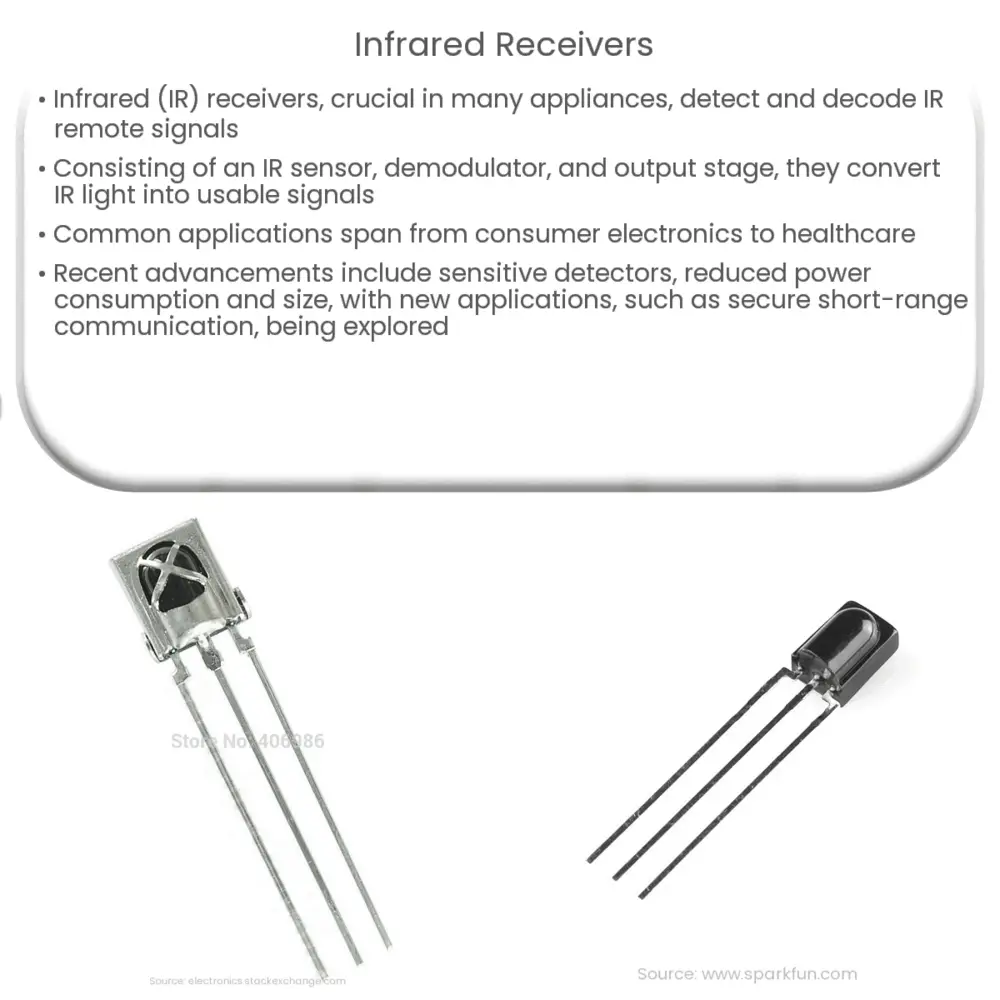Explore the working, components, applications, and advancements of infrared receivers, a crucial component in wireless IR technology.

Infrared Receivers: An Overview
Infrared (IR) technology has significantly impacted our daily life in numerous ways, including the operation of many of our household appliances. At the heart of this technology lies a critical component known as the Infrared Receiver. This component is responsible for detecting and decoding signals from IR remote controls used for televisions, air conditioners, and other appliances.
Functioning of Infrared Receivers
The fundamental operation of an infrared receiver is based on the principle of infrared communication. IR communication is a wireless communication method that uses infrared light waves to transmit data. The process begins when an IR transmitter, like a remote control, sends out an IR signal. The infrared receiver then catches these signals and interprets them into an understandable format for the device it is attached to.
- Infrared light: This is a type of light that is invisible to the human eye. Its wavelength ranges from 700 nanometers (nm) to 1 millimeter (mm). It is within this spectrum that IR communication occurs.
- IR Transmitter: The IR transmitter is a component that emits IR light in a specific pattern corresponding to the command from the user.
- IR Receiver: The receiver’s role is to detect this emitted light. It is usually a photodiode or phototransistor that can detect and measure the light intensity.
Components of Infrared Receivers
Typically, an infrared receiver consists of three main parts: the IR sensor or detector, the demodulator, and the output stage.
- IR Sensor or Detector: This is the component that detects IR radiation. It converts the infrared light into an electric signal. The output is usually in the form of a current that is proportional to the detected IR radiation intensity.
- Demodulator: The demodulator takes the output from the sensor and converts it into a form that the attached device can understand. It effectively decodes the signal into distinct digital signals.
- Output Stage: Finally, the output stage prepares the demodulated signal for consumption by the connected device, often driving it to match the device’s logic levels.
This is just a basic introduction to the functionality and construction of infrared receivers. In the next section, we will delve deeper into the applications and advancements in infrared receiver technology.
Applications of Infrared Receivers
Infrared receivers find their applications in a wide array of devices and industries. Some of the common applications include:
- Consumer Electronics: One of the most common uses of infrared receivers is in consumer electronics. Televisions, home theaters, air conditioners, and other appliances use IR receivers to interpret signals from their respective remote controls.
- Industrial Applications: Infrared receivers are also used in several industrial applications, like safety systems, for detecting heat signatures and object detection.
- Healthcare: The medical field employs IR technology in various diagnostic equipment like infrared thermometers and night vision cameras in surgical procedures.
- Computing: Some computer peripherals like wireless mouse and keyboards also use infrared receivers for wireless communication.
Advancements in Infrared Receiver Technology
In recent years, significant strides have been made to improve the efficiency and capability of infrared receivers. The development of highly sensitive detectors, capable of detecting even the slightest changes in IR radiation, is one such advancement. Other improvements include lower power consumption, reduced size, and the ability to work in a broader range of environmental conditions.
New applications of IR technology are continually being explored. For instance, IR communication is gaining traction in the area of secure short-range communication as it doesn’t penetrate walls like radio waves, thereby reducing the risk of eavesdropping. Furthermore, IR is being looked at as a possible data transfer method in future wireless technology standards due to its high-speed potential.
Conclusion
In conclusion, infrared receivers play a pivotal role in our day-to-day life, often unseen but highly influential. From helping us change TV channels to ensuring safety in industries, their utility is broad and indispensable. The current pace of technological advancement promises even more exciting applications for infrared receivers in the future. Despite the rising prominence of radio frequency (RF) technology, the relative simplicity, cost-effectiveness, and robustness of IR technology ensure its continuing relevance in our increasingly interconnected world.

